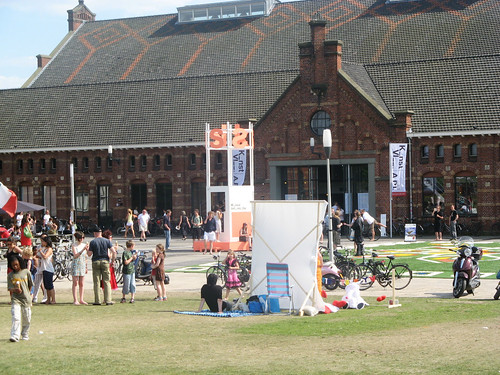Within the company URBANUS, we recently developed an urban design project dealing with upgrading industrial building stock to be used as a densly productive area for creative industrial production. The project was featured in the exhibition 'Re-Start' in Shenzhen's OCT-Loft cultural district in July and August 2011. Here I want to provide some background info about the project and images from the opening showing the different urban design proposals.
 |
| View over OCT-Loft area to be upgraded. (click to enlarge) |
As curator Li Sha is explaining the context of the exhibition:
"Since 2004, OCT started to upgrade the remaining East Industrial Zone to the Creative Cultural Park (named OCT-Loft). The upgrade of the Eastern Industrial Zone in Overseas Chinese Town to the Creative Culture park (OCT-Loft) shows it only took 26 years to complete the transformation of a European industrial city that was projected to take 100 years. [...]
In recent decades, with the transformation and decline of large industrial systems in Europe and in the US, the protection and regeneration of earlier industrial heritage became a trend. The industry was upgraded as the region became increasingly more well known; however, the site is protected both by a respect for the natural surroundings and by archaeological practices, one that places extreme respect on the context and space. [...]
 |
| 'Landschaftspark Duisburg Nord' (Latz&Partner, 1990-1999). Industrial heritage carefully re-purposed with respectful archaeological approach. (Image source: wikipedia) |
Upgrading of these areas will undoubtedly protect the industrial architectural heritage, and enrich the city's creative cultural space, but they have several issues: the area is difficult to adapt to the rapidly changing urban space; the aim for future development is unclear, and it could easily be transformed into a high-end fashion area; the area may have difficulty meeting the demand for new space in the region.
 |
| Zeche Zollverein in Essen, Germany. (image source and credit: Claus Moser @ Flickr) |
 |
| Culturpark Westergafabriek. An old gasworks site refurbished to allow urban cultural events and host creative industrial entrepreneurs. (image by PLANETART @ Flickr] |
 |
| Culturpark Westergasfabriek, Amsterdam. The old 'gashouder' (gas storage tank) used for an exhibition. (image by Bas Boerman @ Flickr) |
 |
| Culturpark Westergafabriek. The same gas storage tank as above used for a rave event. (image by Gia Vasilevska @ Flickr) |
The exhibition invited Bernard Tschumi Architects (New York / Paris), Dominique Perrault Architecture (Paris), MVRDV (Rotterdam), Urbanus - Architecture and Design (Shenzhen /Beijing) and Sou Fujimoto Architects (Tokyo) to offer thoughts on the OCT-Loft conceptual plan and the renovation of B10 into the OCT Contemporary Art Museum, exploring the strategy for the active protection of the industrial building."
It is fair to say here that this 'respect mentioned by Li Sha is not always a given in Europe. It is not uncommon that private as well as public investors just dont acknowledge or can imagine the heritage value of industrial buildings dating back a few decades. The problem in such a case is: you loose a type of architectural heritage, a unique form of space, which would be able to host an array of diverse events, being it cultural or representational. Such rough industrial heritage spaces may also provoke creative re-actions in these spaces which are impossible to create in sleek museum-like environments.There is something to architectural form which was created for another purpose in the past. So the really creative and culturally valuable act is actually a (sometimes temporary) re-purposing of industrial architectural heritage.
After this more theoretical and contextual introduction please have a look at some images of the contributions:
Bernard Tschumi Architects
Domique Perrault Architecture
MVRDV
URBANUS
Sou Fujimoto Architects

















No comments:
Post a Comment